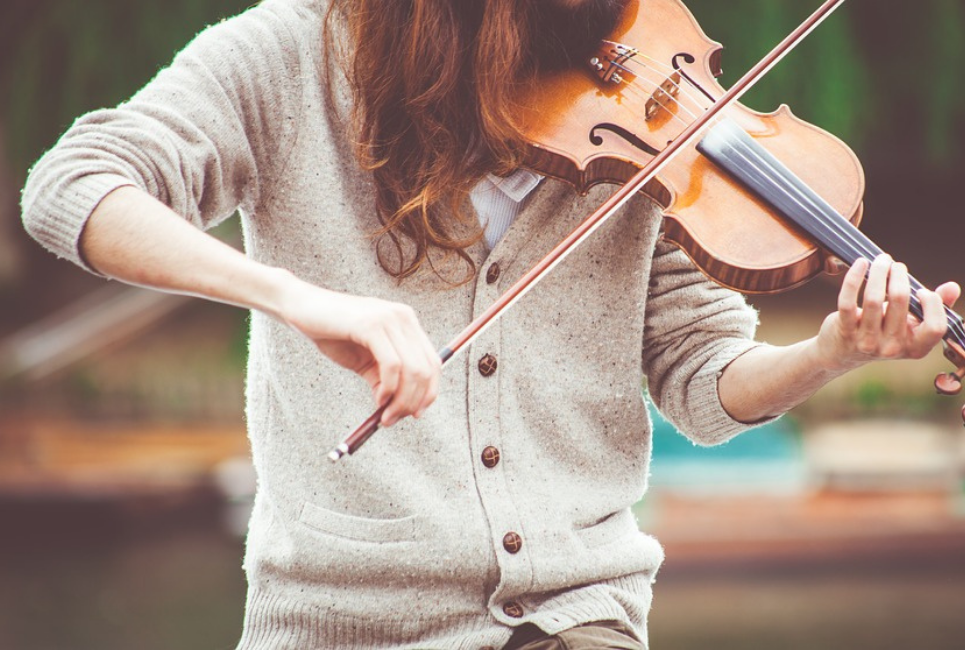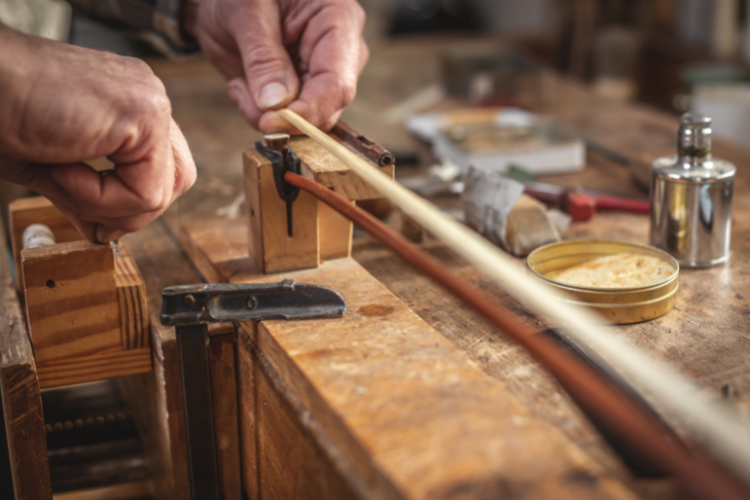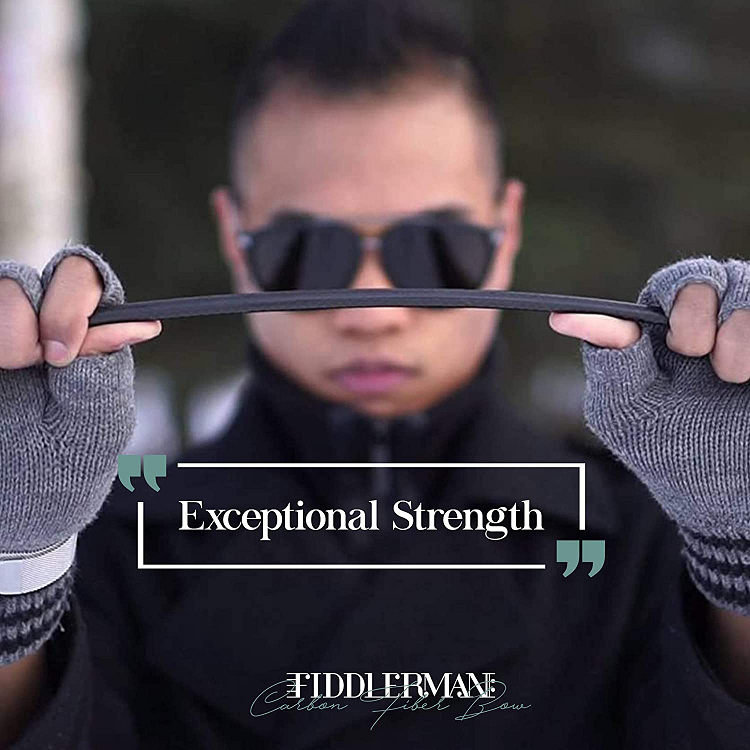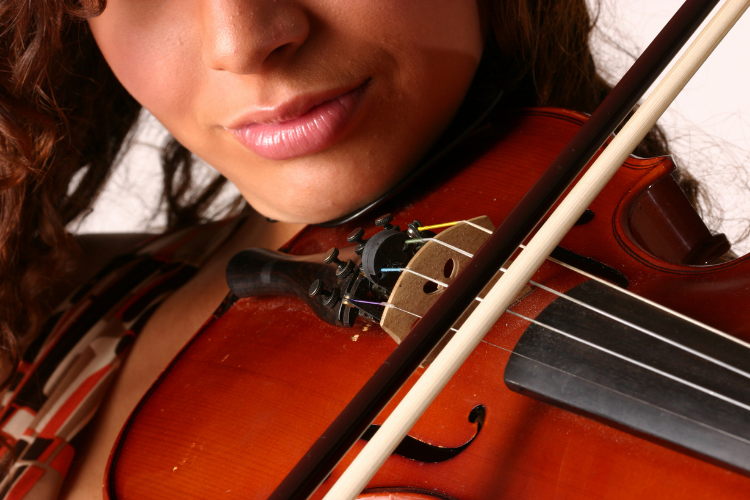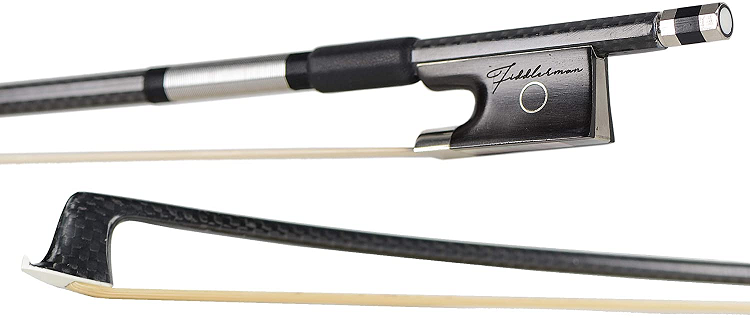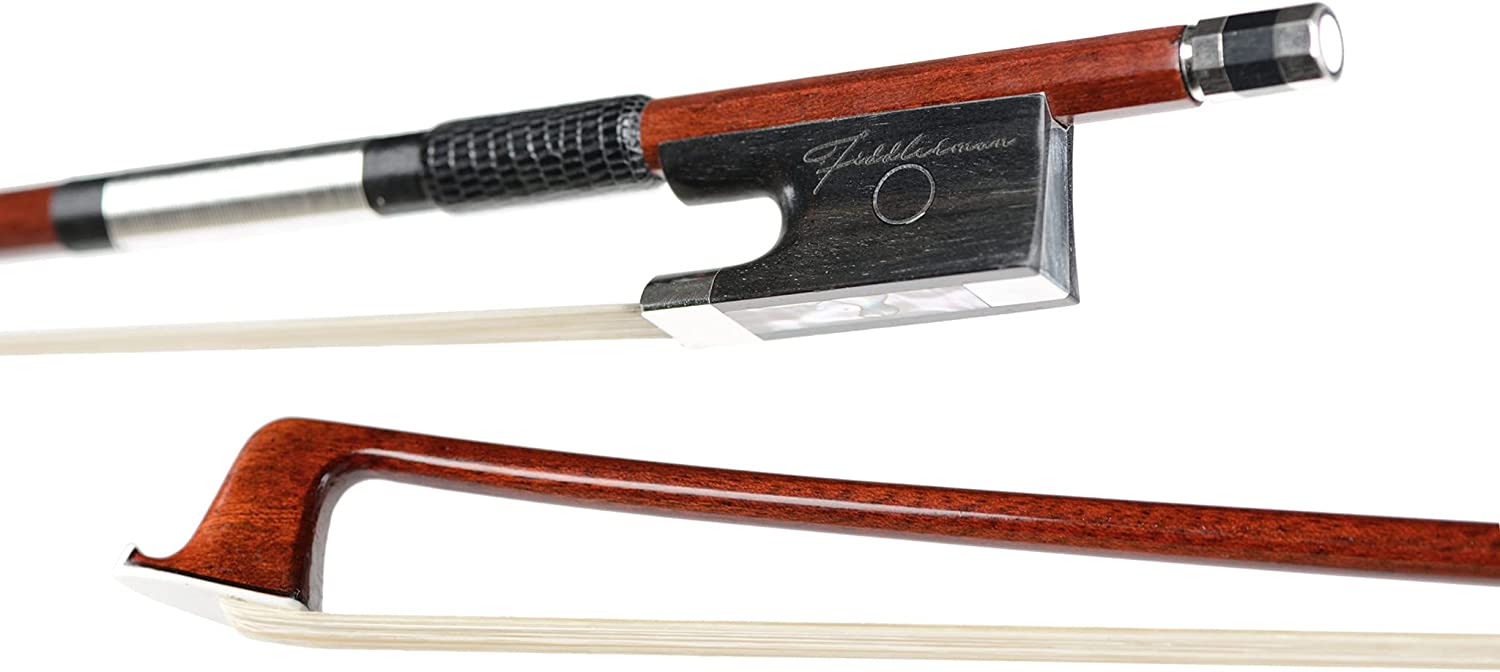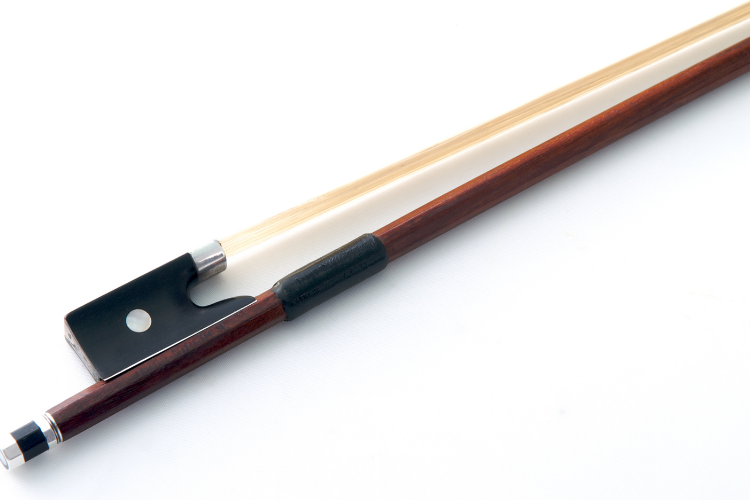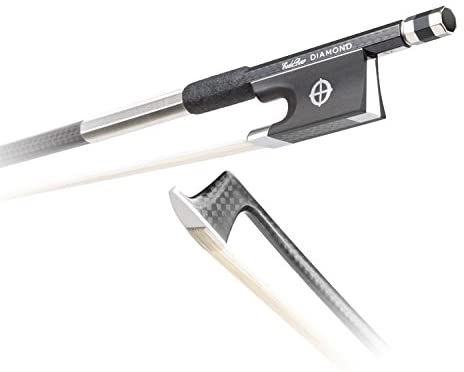- How to Learn to Play Cello Guide: The Only Guide You Need to Get Started - April 18, 2022
- How to Find the Best Trumpet Tuner - April 14, 2022
- Best Carbon Fiber Violins Guide: Why You Need the Glasser Carbon Composite Violin - April 13, 2022
Have you ever gone shoe shopping?
If you’re anything like me, you may spend a few hours walking around the store, trying on a bunch of different shoes. I’ll take a few steps in a shoe, jump – do everything I can to test it out a little bit. I’m really particular when it comes to shopping for shoes – and if I can’t find the perfect fit, I’m not going to buy the shoes.
You may be asking, “Alizabeth, what does shoe shopping have to do with buying a violin bow?”
Patience, friend. Patience.
Finding a violin bow is a lot like the painstaking process of buying shoes. There are a lot of different bows on the market, and not every bow is going to be suited to what you need. And just like with shoes, you can’t really take another person’s suggestion when it comes to deciding on what one bow will be the best option for you.
So, as you’re looking around, add all of the different brands, models, and pricing options available, go quickly come to find that finding the best violin bow takes a lot (and I mean a lot) of patience.
Finding the right violin bow comes down to finding out what feels right in your hands. No 2 bows are going to feel the same in your hands. Searching around for a new violin bow honestly cut down to figuring out which bow is best suited for the violin you currently have, as well as figuring out what feels the best in your hands.
The good news is, is that there are some brands and models out there that are universal. These options are a safe bet that a lot of people count on to take their playing to the next level. But, just because something is a safe option doesn’t mean it’s the best option.
So, I’m here to help you figure out how to decide what the best violin bow looks like for you. I’m going to break down how you can find the best options on the market by identifying what you should look out for and how to test out a bow for yourself.
Is a Violin Bow Really that Important?
If you’re new to the world of stringed instruments, especially the violin, you may not be aware of how important a bow is in relation to the overall tonal quality and playability of your instrument. Finding a good violin is hard enough. But if you end up pairing it with a low-quality bow, you’re not going to reach the full potential of your instrument.
If you weren’t already aware, the violin bow is really what makes your instrument have a voice. Your violin bow adds color to your sound and makes articulation possible.
If you previously purchased a bow or your violin came with a bow that was low quality, you may notice that you had a difficult time bowing. There are some violin bows that don’t have good planning or quality materials used to create them. In this instance, these types of bows make plain very difficult.
Ultimately, your goal with a violin bow should be finding a bow so comfortable in your hand that it feels like your bow is an extension of your hand.
What type of violin bow you also need greatly depends on your skill level. As you become a more advanced musician, the violin bow that you’re using may not be able to keep up with all of the advanced skills that are required for you to perform better.
How to Find the Best Violin Bow
Keeping in mind how important it is to find the best violin bow for your instrument, you’re playing style, your skill level, your budget, and your overall needs, learning how to find the best violin bow can be a daunting task.
Plus, when you think about all of the different bows on the market, it can seem like you’re never going to be able to sort through all of the options to find the best option available to you.
I have good news for you – there’s a checklist that you can use to help you decide which bows are good options for you to investigate and which bows you should stay away from.
If you’re new to playing violin and this is the first below you’ve ever purchased, your demands from a bow won’t be as much as someone who’s an advanced musician looking to make an upgrade to a professional level.
Hair
The quality of the hair used on your bow makes a big difference in the music your violin produces sound. Recommend using white horsehair, or horsehair that comes from a northern climate, to be the best hair option for a violin bow.
This is because this type of horsehair is believed to cause more friction, which significantly impacts the sound Your violin produces
Wood
Next, you should take a look at the wood that’s used on the bow you’re looking into. It’s very important for you to know what type of hair and wood has been used in the creation of your bow. If you’re a professional musician looking for a new bow, I would highly recommend Pernambuco as the wood that’s used for your bow.
But, if you’re not a professional musician, the cheapest option (that isn’t cheaply made) is carbon fiber. Any bow made out of brazilwood is for a beginner who doesn’t know what to look for in a bow and isn’t worth your money – even if you are a beginner.
Straightness
This one, you may not think about. If you’re new to the market of bows, you may think that all bows are going to be straight. I mean, shouldn’t this be a basic requirement?
Sadly, not all bow manufacturers produce straight bows. When you’re buying a violin bow, you should double and triple-check to make sure the bow you’re buying is straight.
If the bow has been used before, you’ll find that when you look down the bow, you’ll see a slight curve. This curve will steer towards the right if a right-handed musician uses the bow. It’ll curve to the left if a left-handed musician has been playing with the bow.
Playing with a straight bow is another vital aspect of buying a new bow. If you don’t purchase a straight bow, your bow’s going to squeak more than play notes.
Camber
The camber of your violin bow is the fancy word that’s used to describe the curve that you see when you look at the middle part of your violin bow. This is an important part of your bow because it gives your bow the strength it needs to take the wear and tear you’re going to put it through.
But, it’s important that your bow has enough camber. If it doesn’t have enough, your bow won’t be strong enough. If it has too much, your bow will be weak and may break. Finding the perfect balance here is essential.
Balance
Speaking of balance… yes, we need a section to talk about balance here. The balance of your bow is super important; your violin bow shouldn’t be too heavy or too light at either end. I always like to tell people this: your bow should feel like an extension of your hand.
If you don’t buy the right balance with your bow, you’re going to end up with a very tired hand. And that’s not the only consequence that comes from you playing with a bow that isn’t properly balanced. It’ll also make it difficult for you to perform certain types of strokes, which will also impact your playing style.
Location of Manufacturing
Yup – where your bow is manufactured is an important part of the buying process. I know, I know – that’s a lot of information to know when you’re looking around for a violin bow. But, hear me out for a second.
A lot of violinists know that a violin made in Italy is nearly guaranteed to be top-notch. But, not a lot of beginners know that a top-notch violin bow is found in France. Mirecourt, France, is actually known as the bow-making capital in the world.
This is because back in the 18th century, Mirecourt was a hot spot for international trading. So, it was easy for bow makers in this city to have access to high-quality materials from international countries.
So, if you’re looking to put out top dollar for a violin bow, consider the location. But, also keep in mind that this isn’t a requirement- if you’re looking for a violin bow that isn’t going to cost you an arm and a leg, you don’t have to buy a bow from France.
Bounciness
You’ll want to check to see if your bow has a little bit of bounce in it. That way, you can determine how well your bow will respond to your string. A more professional way to say this would be buoyancy – but I feel like bounciness is way more of a fun word to remember.
An easy way to test this out is by gently taping your violin bow against your wrist. If you feel the vibration of the strings on your wrist, you’ve got a bow that’s good to go (or at least passing this part of the check). You want to invest in a bow that can bounce and respond well to your strings.
Why?
Well, because you want to sound as good as you are, right?
Violin bows that have a lot of bounce to them make it easier for you to play certain musical techniques. If you don’t have a bow that responds well, you’re no better playing with a stick. Heck, playing with a stick would be a lot cheaper.
The Condition
Next, it’s also important for you to take the condition of the bow into consideration. This is especially important if you’re looking at buying a used bow. Before you put down your payment, carefully look over the entirety of the bow.
Do you notice any repairs? Are there any cracks, even if they’re super small?
If you did find these things, the bow isn’t very valuable.
However, buying a bow refurbished vs. used means two different things. A refurbished bow I a great option if you don’t have a whole lot of money to invest tina bow but still want the chance to play with a higher-quality bow than the one you got with your violin kit.
Budget
Of course, you should always take your budget into consideration before you make a final decision in purchasing one bow. If you’re getting ready to go into a shop for the first time to look around for different bows, you have to be prepared to look at bows that are a little bit above your price range.
Doing this will allow you to figure out if you need to move up in quality because of the advancement in your skill.
The Best Violin Bows
I chose all of the violin bows that I’ve listed in this guide based on availability, overall quality, the reputation of the manufacturer, and my personal experiences with each bow.
As a side note, I would recommend that if you’re going in-store to buy a bow, I would shop at a company that allows you to take the bo home temporarily before you purchase it.
Doing this will allow you to test out the bow that you’re considering buying in the location where you’ll be playing your violin the most. You may be surprised at the differences in sound quality from when you’re testing the violin bow while you’re in-store versus when you’re playing at home.
Also, I would highly recommend that you find a way to only focus on the sound quality of your violin bow. When you’re testing out a bow, don’t try to play a piece that you’re currently working on perfecting. Instead, play something that you have memorized or play some scales.
When you’re testing out your violin bow, you shouldn’t focus on reproducing a sound that you’re already familiar with. Instead, you should focus on seeing if the bow you’re using improves your overall sound quality.
Lastly, before we get into the recommendations, make sure that you weren’t pressured into buying anything. There are a lot of different people out there who play a certain style of music and others who play a different style.
Everyone’s violin journey looks and sounds different, so don’t feel pressured into buying a bow that a music salesman makes out to be the best violin bow on the market. Instead, you should focus on figuring out what works best for you end the violin you’re playing on.
With all of that said, here are my top recommendations for the best violin bows on the market.
Fiddlerman Carbon Fiber Weave Bow
This is an outstanding violin bow. Plus, I’m not the only person who believes so. There are a lot of people who talked about how amazing the quality of this carbon fiber bow it is. In my opinion, this is the best carbon giber bow on the market that’s worth the investment, especially if you’re on a super tight budget.
I love the sleek appearance this carbon fiber bow has. I think it’s a great option to look into if you’re an intermediate player looking to see how much our overall sound quality improves with the purchase of a new bow. I wouldn’t recommend this bow to someone who’s a professional or is an advanced violin player.
If you are a professional, the reason why I wouldn’t recommend this bow is that the carbon fiber in this bow doesn’t provide the same level of warmth that a natural wood bow does. But, I do love the way that this carbon fiber bow handles, which is why I think it’s a great option for intermediate musicians.
Plus, this carbon fiber weave bow is made with super high-quality Siberian horsehair, so you aren’t making a sacrifice in the overall quality of the bow by having some sort of cheap bow hair installed.
Pros
- Super durable
- Very affordable, especially for the quality
- Isn’t heavy
- Has a nice balance
Cons
- Doesn’t provide a lot of warmth to your overall sound
Fiddlerman Wood and Carbon Fiber Hybrid Violin Bow
Now, you’ll notice how I brought up the Fiddlerman carbon fiber weave bow not having a lot of warmth to it. So, that’s a huge deal-breaker for you; you should look into getting the wood and carbon fiber hybrid bow as an option.
If you’ve never heard of a hybrid bow, basically, this bow is made with both carbon fiber and wood. That way, you’re able to play with the best of both worlds.
You won’t have to spend a ton of money as you would with a wooden bow, but you also get warmth out of this bow that you wouldn’t find in a bow that’s made with solid carbon fiber.
Just like with the other bow I recommended, this wood and carbon fiber hybrid bow is made with high-quality Siberian horsehair. And while there are some people who may be worried that a wooden hybrid bow is heavier than a carbon fiber bow, I can assure you this isn’t something you’ll need to worry about.
Pros
- Aesthetically pleasing, especially if you like the appearance of a wooden bow
- Has a great balance
- I love the Frog on this bow; it adds a little bit of fun flair to the overall look of the bow
- Affordable
- Lightweight
Cons
- Isn’t a great bow for intermediate or advanced musicians
Pernambuco Holestein Pernambuco
If you’re looking for a wooden high-end violin bow, this is the bow for you. This is a great violin bow for someone who isn’t super advanced but is interested in learning how to play with a wooden bow. This was one of the first bows that I learned how to play with, so it’s got a special place in my heart.
I bought it because I wanted to learn how to play the violin and some of my teachers told me that carbon fiber bows just weren’t worth it. So, the affordability of this bow attracted me to add to it to this list.
Plus, this violin bow is also made with Siberian horsehair and lizard skin on the wrap to ensure durability.
Pros
- Made from Pernambuco wood
- Very affordable
- A wooden bow that’s easy to approach for beginners and intermediate players
Cons
- You won’t get the same level of tone out of this bow that you would get with other higher-end wooden bows.
CodaBow Diamond SX Carbon Fiber Bow
I think this bow is an awesome option for someone looking to transfer to an intermediate or advanced level bow. This bow comes with a 10-year limited warranty that is available to only the original registered owner. However come up for you to get this warranty, your bow does have to be purchased from an authorized dealer.
Also, it comes with a kevlar acoustic core, which I feel really helps to add to the brightness and responsiveness of this bow.
I haven’t tested this bow out before, and I really enjoyed the response that this bow had without sacrificing its durability and lightweight properties.
I think that this bow is great for someone who is an intermediate player and is interested in taking their skill up to the next level. This bow does cost a little bit more of an investment, which is why I wouldn’t necessarily recommend it to a beginner.
However, if you’re serious about playing the violin and know that it’s already an instrument you love, this is a great option for you to use. Plus, it’s a Carbon Fiber bow, so even if you aren’t the most careful musician, this will still be able to withstand some wear and tear and clumsiness.
Pros
- I love all the attention to detail paid with the inlays
- The fittings that come with this below are super classy looking, so it won’t be obvious that you are playing with a semi-affordable bow
- Uses gold medal stallion hair
- Has a beautifully bright tone
Cons
- You may find this boat a bit flashy, depending on your aesthetic background
FAQs
Answer: Yes, a violin bow can be restrung. However, I would honestly only recommend that you have your violin bow restrung by a professional. Have a great you are a violin bow restrung doesn’t cost a lot of money. But, if you try to do it yourself, there’s a high chance that you could damage your bow and impact the integrity.
Answer: It’s very difficult for you to watch violin bow hair. It’s also not something that I would recommend. I think that if you’re good just going to take the time to wash your violin bow hair, I think that you should make the effort of taking your bow to a shop and getting it repaired.
However, there are some musicians that swear by washing their violin bow hair with warm water and soap.
This is something that I tried once before on super low quality of violin bow. And the overall quality of the bow didn’t have much to speak for before I washed it. But, there is definitely a significant downgrade in the overall quality by the time I finished washing it.
So, I would highly recommend that you don’t wash your violin bow hair.
Answer: Yes, the overall quality of your violin bow is super important. A lot of people think that it doesn’t have a huge impact on the overall sound quality of your instrument. But, this isn’t true.
The violin bow make a huge impact on the overall sound of your instrument come on as well as how easy it is to play. That’s why you need to make sure that the violin bow you are purchasing matches with the overall quality of your violin.
Conclusion
Overall, I would highly recommend the Fiddlerman Wood and Carbon Fiber Hybrid violin bow. I think that this bow has a lot to offer, especially since it combines a little bit of the best qualities that both carbon fiber bows and wooden bows have to offer.
Plus, you can get the best of both worlds without breaking your bank, so I’m not really sure what else a violin bow I could offer that this bow doesn’t already have.
Are you interested in learning more about how to buy the best violin on the market for your price range? Don’t worry, we have guides here to help you with that too.
Looking for more interesting readings? Check out:

